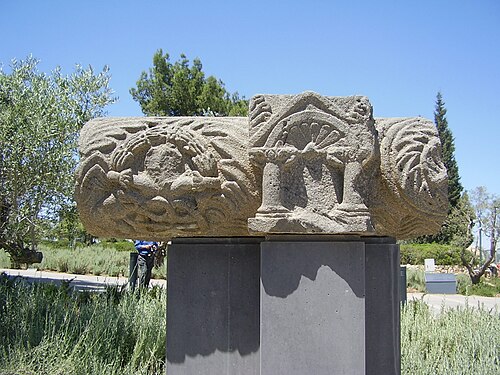Khirbat Karraza or Chorazin | |
|---|---|
Village | |
 Ancient synagogue at Chorazin | |
 Interactive map of Khirbat Karraza or Chorazin | |
| Coordinates:32°54′40″N35°33′46″E / 32.91111°N 35.56278°E /32.91111; 35.56278 | |
| Date of depopulation | May 4, 1948 |
Chorazin (Greek:Χοραζίν/koʊˈreɪzɪn/; also Chorazain) orKorazim (Hebrew:כורזים; also Chorizim) was an ancient village in theRoman andByzantine periods, best known from the ChristianGospels. It stood on theKorazim Plateau in theUpper Galilee on a hill above the northern shore of theSea of Galilee, 2.5 mi (4.0 km) fromCapernaum in what is now the territory of modernIsrael.
Khirbat Karraza (also Karraza, Kh. Karazeh, Kerazeh) was a village established at the site of the ancient village anddepopulated during the1947–1948 Civil War in Mandatory Palestine on May 4, 1948, by thePalmach's First Battalion duringOperation Yiftach. It was located 8.5 km southeast ofSafad.
The nearby Israeli town ofKorazim is named for this location.
Two settlement phases[which?] have been proposed based on coin and pottery findings.[1] The town was partially destroyed in the 4th century, possibly as a result of an earthquake.[2] The settlement of Khirbat Karraza subsequently developed on the site.[when?][citation needed]

DuringOttoman control, Khirbat Karraza was populated by the Zanghariyya Bedouin tribe and the village contained a shrine for a local Muslim saint, al-Shaykh Ramadan. The villagers used to store grain close to the shrine, certain that nobody would steal it and thereby violate the sanctity of the shrine.[3]
The Palestinian historianWalid Khalidi described the site in 1992: "Some village houses still stand, together with the remains of other houses. One of the old houses has been renovated. Also remaining is the tomb of Shaykh Ramadan, around which the village shrine had been built. The tomb is collapsing and the building in which it was housed no longer exists. It is surrounded by largecarob trees."[3]
Extensive excavations and a survey were carried out in 1962–1964. Excavations at the site were resumed in 1980–1987. In 2004, a small-scale salvage excavation was conducted by theIsrael Antiquities Authority along the route of an ancient road north of MoshavAmnun. In the literature, the road is referred to as "the way through Korazim." It crossed the Chorazin plateau from west to east, branching off from the main Cairo–Damascus road that ran northeast towardDaughters of Jacob Bridge.[4]
The main settlement dates to the 3rd and 4th centuries. The majority of the structures found were made frombasalt, a black volcanic rock found locally.[5] The town's ruins are spread over an area of 25 acres (100,000 m2), subdivided into five separate quarters, with asynagogue in the centre. Close by is a ritual bath (mikvah), surrounded by public and residential buildings. The handful ofmillstones used inolive oil extraction found suggest a reliance on the olive for economic purposes, like other villages in ancient Galilee.

Asynagogue whose ruins are still visible today was built in the late 3rd century, destroyed in the 4th century, and rebuilt in the 6th century.[6] The large synagogue which was built of basalt stones and decorated with Jewish motifs is the most striking of the surviving structures. An unusual feature in an ancient synagogue is the presence of three-dimensional sculpture, a pair of stone lions. A similar pair of lions was found in the synagogue atKfar Bar'am.[7] Other carvings, which are thought to have originally been brightly painted, feature images of wine-making, animals, aMedusa, an armed soldier, and an eagle.[8]
Jacob Ory (born 1898 in Russia[9]), who excavated the site in 1926 on behalf of theBritish MandateDepartment of Antiquities, wrote about a second synagogue ca. 200 m west of the first one, and he described it in detail. Later excavations, however, have not been able to find the remains noted by him and confirm the existence of such a building.[10]
Chorazin, along withBethsaida andCapernaum, was named in theChristian gospels ofMatthew andLuke as cities in whichJesus of Nazareth performed his mission. However, because these towns seemingly rejected his message ("they had not changed their ways"), they weresubsequently cursed (Matthew 11:20-24;Luke 10:13-15). Because of this condemnation, the influential but non-canonicalApocalypse of Pseudo-Methodius predicted that theAntichrist would be conceived in Chorazin.[11]
The English theologianJohn Lightfoot writing in the 17th century suggested that Chorazin might have referred to a wider area aroundCana in Galilee, rather than a single city/village:
In hisBiblical Researches in Palestine in the mid-nineteenth century,Edward Robinson visited Khirbat Karraza, but concluded it was not the Biblical Chorazin, because the ruins were not significant enough and the site was not near the shore of theSea of Galilee, as stated byJerome (Lacum Genesareth, in cujus litore Capernaum et Tiberias et Bethsaida et Chorozaim sitæ sint):[13]
The ruins we had been told of lie on the west side of this same valley, a quarter of a mile southwest, near its entrance into the main Wady. They consist simply of a few foundations of black stones ; the remains evidently of a poor and inconsiderable village. They are known as Khirbet Kerâzeh. We did not go to them, as there was no path; and because they were in full view. Their distance from Tell Hùm must be reckoned at about three miles. We had come to this spot, because the name Kerázeh bears a degree of resemblance to the Chorazin of the New Testament; and we hoped to find, in the ruins or the situation, something which might determine the position of that ancient place. In this we felt ourselves disappointed. The remains are too trivial to have ever belonged to a place of any importance. Chorazin, too, according to Jerome, lay upon the shore of the lake; but this site is an hour distant. shut in among the hills, without any view of the lake, and remote from any public road whether ancient or modern.
Chorazin is referred to in the 1904 ghost story "Count Magnus", byM. R. James.[14]



Former and current villages inhabited by the Zanghariyya Bedouin tribe:
{{cite book}}:ISBN / Date incompatibility (help)